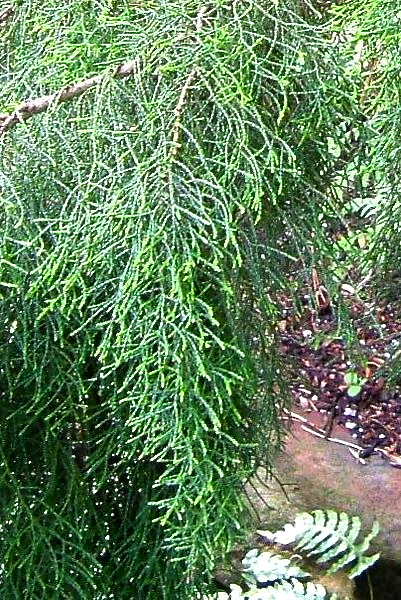Lagarostrobos franklinii is a species of conifer native to the wet southwestern corner of Tasmania, Australia; it is the sole species in Lagarostrobos; one other species L. colensoi formerly included has been transferred to a new genus Manoao. The genus was also formerly included in a broader circumscription of the genus Dacrydium.
Lagarostrobos franklinii is often known as the Huon pine or Macquarie pine, although it is actually a podocarp (Podocarpaceae) not a true pine (Pinaceae).

It is a slow growing, but long-lived tree; some living specimens of this tree are in excess of 2000 years in age. It grows to 10 to 20 m tall, exceptionally reaching 30 m, with arching branches and pendulous branchlets. The leaves are spirally arranged, very small and scale-like, 1 to 3 mm long, covering the shoots completely. It is dioecious, with male (pollen) and female (seed) cones on separate plants. The male cones are yellow, 5 to 8 mm long and 1 to 2 mm broad. The mature seed cones are highly modified, berry-like, with 5 to 10 lax, open scales which mature in 6-8 months, with one seed 2 to 2.5 mm long on each scale. Unlike the closely related New Zealand genus Manoao, the scales do not become fleshy and are water-dispersed, not bird-dispersed.[2]
A stand of trees reputed to be in excess of 10,500 years in age was recently found in Western Tasmania on Mount Read. Each of the trees in this stand is a genetically identical male that has reproduced vegetatively. Although no single tree in this stand is of that age, the stand itself as a single organism has existed that long.
The wood was highly prized for its golden yellow colour, fine grain and natural oils that resisted rotting. The chemical that gives the timber its unique smell and preservative qualities is methyl eugenol. Heavy logging of the trees for its timber coupled with the trees' slow growth has led to remaining stands being less than 105 square kilometres (26,000 acres).
It has been planted in the grounds of Crathes Castle, Aberdeenshire, Scotland and has done well. Two healthy specimens can also be found at Torosay Castle, Isle of Mull.